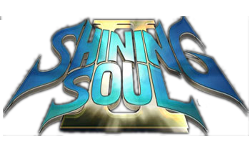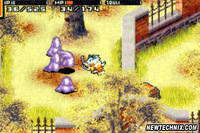|
|

|
PLATFORM
|
GBA
|
BATTLE SYSTEM
|

|
INTERACTION
|

|
ORIGINALITY
|

|
STORY
|

|
MUSIC & SOUND
|

|
VISUALS
|

|
CHALLENGE
|
Moderate
|
COMPLETION TIME
|
Less than 20 Hours
|
|
OVERALL

|
+ Improves on its predecessor
+ Character improvement is changeable
- No immunity to damage after taking a hit
- Quantity of text does not signify quality
- Cramped, cluttered enviroments
- Gets and stays monotonous
|
Click here for scoring definitions
|
|
|
Shining Soul was easy to improve upon, and the task was so simple to accomplish that Sega bankrolled Grasshopper to do so less than a year later. Shining Soul 2 is indeed an improvement over its much-scorned predecessor, though achieving such a thing is the equivalent of a new Super Mario Bros. movie outdoing the first. Grasshopper failed to do much more than the bare minimum of making the game slightly better, leaving the GBA saddled with another hack and slash title that gets boring long before the end.
Eight character classes present themselves when beginning the game, and the differences between them create considerable differences as to how one will tackle the hordes of enemies. The equipment applicable to each class is also rendered unusable if certain statistics are too low, creating an effective goad to put the points gained at level up into the right category. Some classes have projectile attacks while others are speedy and others can heal themselves, altering the methodology necessary for triumphing over the bloodthirsty swarms of foes. Improving skills takes a long time at higher levels, making player choices about development matter. In this respect Shining Soul 2 has simply improved the one notably positive feature of its predecessor, but the difference is appreciated.
Shining Soul 2 also sports more interesting dungeons than its precursor, a fact made apparent when it offers trips through the locales of Shining Soul as optional content. The mandatory portions of 2 don't achieve much beyond varying the visuals though. A few of them have traps that must be side-stepped, and sometimes they have passages to chests with random loot. Otherwise the player will be spending time moving along to trigger enemy appearances, killing everything that pops up, and then repeating until the key opponent that unlocks the exit has been slain. The dimensions of the rooms along the way vary, and occasionally a choice of exit is offered that will alter what comes next in a minor way, but mashing the A button to kill the same adversary repeatedly is still the procedure. Shining Soul 2 sports a better variety of enemies than its predecessor, but plenty of them are functionally identical palette swaps even so. After the first ten floors, one has generally seen just about all that a dungeon has to offer, but the hazards keep coming long after that.
 Somehow Hollywood hasn't gotten around to making the Wolfman fight the Blob. That's probably for the best.
Somehow Hollywood hasn't gotten around to making the Wolfman fight the Blob. That's probably for the best.
|
|
Enemies are still very stupid, but this time around they're harder to pin in corners to abuse. It's also no longer possible to simply run through the opposition, so dying is somewhat easier to do. Shining Soul 2 is quite kind in this regard, tossing the player back to home base with an NPC performing a wake-up monologue. The player is subsequently able to jump immediately back to the last floor with nothing except money lost, and that can be stored in a bank so permanent punishment does not happen. What makes getting killed ridiculously easy is the lack of any immunity to damage after taking a hit, something that can often end a life in mere seconds. The game is remarkably random when choosing which target will be hit when they're packed into a bunch, making any effort to single out foes a crapshoot.
By actually allowing the player to save at any time and resume at the same spot in the dungeon, Shining Soul 2 improves a lacking aspect of the first. Grasshopper seems to have been under the impression that players have short term memory problems preventing the retention of any information, however, as the same text boxes that explain what happens when a save is made must be read every time the option is accessed, plus the game automatically boots the player back to the starting screen after recording progress. This presumption of severe short term memory issues continues if the player decides to revisit a dungeon, for mysterious forces have made sure that every mandatory dialogue moment will be replicated in full. The inability to pause the game is also bothersome.
In crafting the narrative of Shining Soul 2, Grasshopper had the benefit of extremely low expectations. Exceeding that of the first game is achieved, but despite having a much greater quantity of plot, its quality is lacking. Using the defeat of the Dark Dragon at the end of the first game as a starting point, the plot takes place generations later when darkness is again encroaching upon the world and ensnaring servants to undo the age of light. This concept is belabored through interminable dialogue with a royal family about the next destination for the mute player, along with how rotten things have become — which is positively shocking, at least according to the king. Some of the bosses babble about an organization called Chaos Knights, but it affects nothing and is mostly ignored after the game brings up the topic. Many of the text sessions in the game move at a set speed, eliminating the ability to quickly move along. Atlus's localization is workmanlike, since there was nothing in the stillborn plot that could really be brought to life.
 Scorpions are excellent massage performers, great at hitting hard-to-reach places.
Scorpions are excellent massage performers, great at hitting hard-to-reach places.
|
|
At first glance the game's visuals are bright and attractive, though not particularly challenging for the GBA to pull off. Spending some time inside of the dungeons reveals that Grasshopper was fond of foreground graphics that obscure portions of the screen, along with several areas where figuring out what is a navigable spot requires some experimentation. The rampant palette-swapping of opponents is reduced from the first Shining Soul, but can still be odd when several enemies that are supposed to be different come swarming the player. Some of the enviroments manage to be interesting to behold, at least.
Shining Soul 2 features some music that is fairly catchy, though done no real favors by the GBA's capabilities. Several dungeons have genuinely worthwhile tracks to accompany the slaughter of their residents. The sound effects are rather less captivating, especially the ugly squawks of the protagonist when hit.
With friends and GBA link cables, it's possible that Shining Soul 2 becomes an engrossing multiplayer experience. Played solo the dungeons become interminably long with too little done to vary the pace — certainly it's adequate as a means of beating hundreds of enemies to death one by one, but mere adequacy isn't much of an endorsement, especially with all the irritations it possesses. As a Shining title it's pathetic, representing Sega's effort to drive the series in a different direction so Camelot's association could be forgotten. That stratagem seems to have worked, as the series in Japan just keeps going ten years later. I can only hope it improved in subsequent installments.
Review Archives
|









